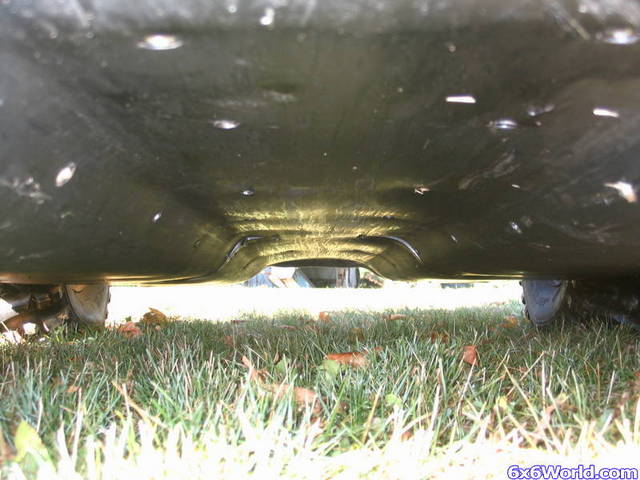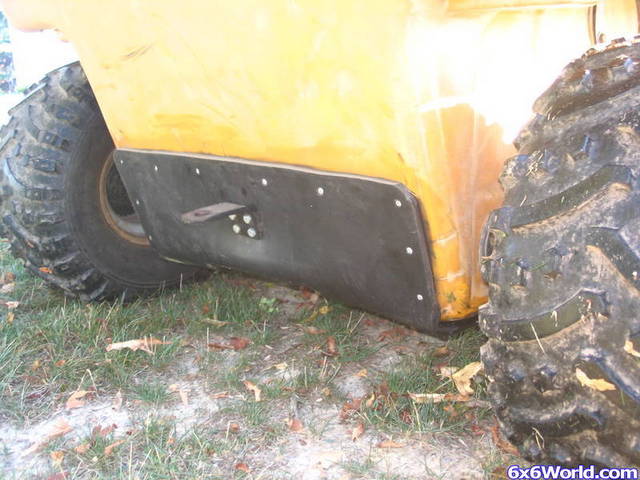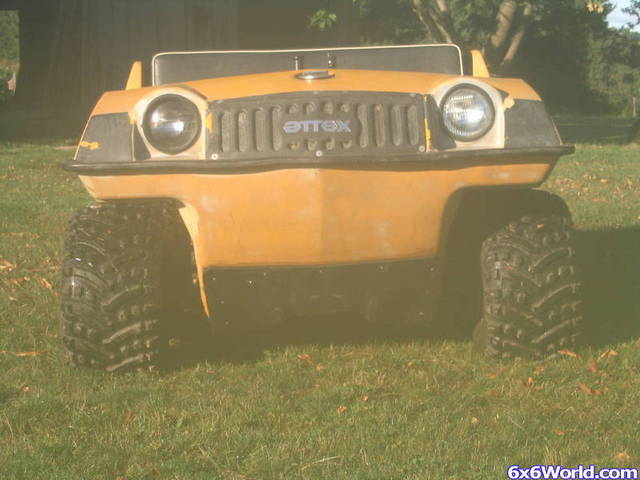I've just about put the finishing touches on the poly skid plate on the Chief. The bottom was cracked in a few spots, and quite frankly, I feel there is no "ultimate fix" to a cracked bottom of you want it to be waterproof, and want to be able to actually use an AATV for its intended purpose. Other fixes include riveting steel to the body(heavy), using fiberglass resin and mat (OK, but doesn't stand up to abuse well) and other methods, but I wanted something that would really take what I wanted to dish out on the machine.
The skid plate is a full 1/4" thick HDPE that is in two pieces. I would have used one sheet, but it had to be cut for shipping. It turns out that two pieces was a bit easier. Its held on with 72 (or so) steel shank waterproof rivets that RI uses on their machines. I was dismayed that I couldn't get the poly to wrap up around the sides well enough to incorporate into the axle flanges. It's plenty strong, though. I'm just not entirely pleased with how it terminates so abruptly on the bottom.
The forming was done with a heat gun. It works tremendously well, as long as you're patient. There was a lot of force with jacks to bend the poly and hold it in place once it was good and mushy. It incorporates the rear trailer hitch, and it has two threaded drain plugs I've added since the pictures were taken. The first time I had it out (and many times since then) I've been forging through the brush and found that I suddenly stopped forward progress altogether. Each time, I was centered on a different large boulder. No cracking, thumping, creaking or anything. It just rides up it and stops. There's virtually no deformation in the body, either. I can jack up the entire machine with a floor jack right in the center of the body. It was quite a bit of work, but well worth it to keep the 'ol gal around for a few more years. There's no water around here yet, so I haven't had the opportunity to check for water-tightness.
I recommend it to anyone with a body that they're thinking about junking because of lower tub issues. The pics aren't great, but you get the idea. More pics in my gallery...



The skid plate is a full 1/4" thick HDPE that is in two pieces. I would have used one sheet, but it had to be cut for shipping. It turns out that two pieces was a bit easier. Its held on with 72 (or so) steel shank waterproof rivets that RI uses on their machines. I was dismayed that I couldn't get the poly to wrap up around the sides well enough to incorporate into the axle flanges. It's plenty strong, though. I'm just not entirely pleased with how it terminates so abruptly on the bottom.
The forming was done with a heat gun. It works tremendously well, as long as you're patient. There was a lot of force with jacks to bend the poly and hold it in place once it was good and mushy. It incorporates the rear trailer hitch, and it has two threaded drain plugs I've added since the pictures were taken. The first time I had it out (and many times since then) I've been forging through the brush and found that I suddenly stopped forward progress altogether. Each time, I was centered on a different large boulder. No cracking, thumping, creaking or anything. It just rides up it and stops. There's virtually no deformation in the body, either. I can jack up the entire machine with a floor jack right in the center of the body. It was quite a bit of work, but well worth it to keep the 'ol gal around for a few more years. There's no water around here yet, so I haven't had the opportunity to check for water-tightness.
I recommend it to anyone with a body that they're thinking about junking because of lower tub issues. The pics aren't great, but you get the idea. More pics in my gallery...



 Very creative. How thick is that? I have alum skid plates down the troughs of my Attex and they are torn up pretty bad already. I hate to think what it would look like without them. I think what you've done would slide over things a lot better. Great job.
Very creative. How thick is that? I have alum skid plates down the troughs of my Attex and they are torn up pretty bad already. I hate to think what it would look like without them. I think what you've done would slide over things a lot better. Great job.

 NICE, clean install. You say it forms decent when heated? Did you form it then seal it before riviting? just worried about heating it with the sealent on, weather it would hurt the bond by making it set-up faster. Sorry about so many questions, I just bought some of that 1/4" thick HDPE to put on my Argo. Ummmm....hey Mike by the way.......can I borrow a tractor or two?
NICE, clean install. You say it forms decent when heated? Did you form it then seal it before riviting? just worried about heating it with the sealent on, weather it would hurt the bond by making it set-up faster. Sorry about so many questions, I just bought some of that 1/4" thick HDPE to put on my Argo. Ummmm....hey Mike by the way.......can I borrow a tractor or two?  and only doing a 4' X 4' sheet at a time. I was wondering if it could be boiled in hot water to make it soft in order to form it and using a rolling pin first then going over it with a heat gun to finish it up.Im not sure if it will work but would be nice and alot faster than using a heat gun only. Just wanted to see what you guys think and if you have any other ideas or advice..??..
and only doing a 4' X 4' sheet at a time. I was wondering if it could be boiled in hot water to make it soft in order to form it and using a rolling pin first then going over it with a heat gun to finish it up.Im not sure if it will work but would be nice and alot faster than using a heat gun only. Just wanted to see what you guys think and if you have any other ideas or advice..??..
Comment